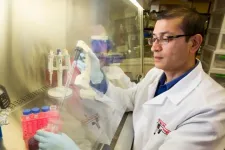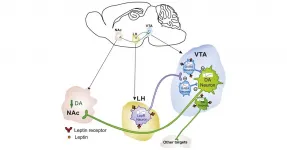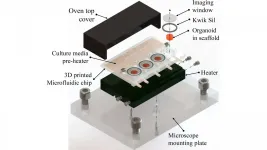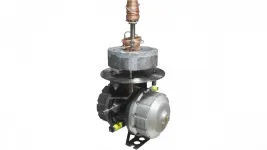(Press-News.org) At a cost of $38 billion a year, an estimated 5.3 million people are living with a permanent disability related to traumatic brain injury in the United States today, according to the Centers for Disease Control and Prevention. The physical, mental and financial toll of a TBI can be enormous, but new research from the University of Georgia provides promise.
In a new study, researchers at UGA's Regenerative Biosciences Center have demonstrated the long-term benefits of a hydrogel, which they call "brain glue," for the treatment of traumatic brain injury. The new study provides evidence that not only does the gel protect against loss of brain tissue after a severe injury, but it also might aid in functional neural repair.
Brain damage following significant TBI commonly results in extensive tissue loss and long-term disability. There currently are no clinical treatments to prevent the resulting cognitive impairments or tissue loss.
Reported on March 5 in Sciences Advances, the new finding is the first to provide visual and functional evidence of the repair of brain neural circuits involved in reach-to-grasp movement in brain glue-implanted animals following severe TBI.
"Our work provides a holistic view of what's going on in the recovery of the damaged region while the animal is accomplishing a specific reach-and-grasp task," said lead investigator Lohitash Karumbaiah, an associate professor in the University of Georgia's College of Agricultural and Environmental Sciences.
Created by Karumbaiah in 2017, brain glue was designed to mimic the structure and function of the meshwork of sugars that support brain cells. The gel contains key structures that bind to basic fibroblast growth factor and brain-derived neurotrophic factor, two protective protein factors that can enhance the survival and regrowth of brain cells after severe TBI.
In a prior short-term study, Karumbaiah and his team showed that brain glue significantly protected brain tissue from severe TBI damage. In this new research, to harness the neuroprotective capacity of the original, they further engineered the delivery surface of protective factors to help accelerate the regeneration and functional activity of brain cells. After 10 weeks, the results were apparent.
"Animal subjects that were implanted with the brain glue actually showed repair of severely damaged tissue of the brain," said Karumbaiah. "The animals also elicited a quicker recovery time compared to subjects without these materials."
To measure the glue's effectiveness, the team used a tissue-clearing method to make brain tissue optically transparent, which allowed them to visually capture the immediate response of cells in the reach-to-grasp circuit using a 3D imaging technique.
"Because of the tissue-clearing method, we were able to obtain a deeper view of the complex circuitry and recovery supported by brain glue," said Karumbaiah. "Using these methods along with conventional electrophysiological recordings, we were able to validate that brain glue supported the regeneration of functional neurons in the lesion cavity."
Karumbaiah pointed out that the RTG circuit is evolutionarily similar in rats and humans. "The modulation of this circuit in the rat could help speed up clinical translation of brain glue for humans," he said.
With support from UGA's Innovation Gateway, Karumbaiah has filed for a patent on the brain glue. He is also partnering with Parastoo Azadi, technical director of analytical services at the UGA Complex Carbohydrate Research Center, and GlycoMIP, a $23 million, National Science Foundation-funded Materials Innovation Platform, created to advance the field of glycomaterials through research and education.
"Doing the behavioral studies, the animal work and the molecular work sometimes takes a village," said Karumbaiah. "This research involved a whole cross-section of RBC undergraduate and graduate students, as well as faculty members from both UGA and Duke University."
The collaborative research effort provided five UGA RBC fellow undergraduates with an experiential learning opportunity and to publish their first paper. This is the first publication for Rameen Forghani, an aspiring M.D.-Ph.D. undergraduate working in the Karumbaiah lab.
Forghani said the undergraduate team "learned how to collaborate on this project" and about the impact of moving lab research to patients who need treatment.
"My fellow undergraduates and I were empowered to take ownership of a piece of the project and see it through from the planning stages of data analysis to writing and being published," said Forghani. "As an aspiring, early-career physician-scientist, working on a project that has translational impact and directly addresses a very relevant clinical problem is very exciting to me."
Charles Latchoumane, research scientist in the Karumbaiah lab and first author on the study, divides his time between UGA and Lausanne, Switzerland, where he works at NeurRestore, a research center aimed at restoring lost neurological function for people suffering from Parkinson's disease or from neurological disorders following a head injury or stroke.
"This study has been four to five years in the making," said Latchoumane. "Our collaborative research is so painstakingly documented that, after you read about it, you have to believe there is new hope for severe victims of brain injury."
INFORMATION:
This work was supported by grants to Karumbaiah from the National Institutes of Health (RO1NS099596, R24GM137782), the Regenerative Engineering and Medicine Center seed grant program, and an Alliance for Regenerative Rehabilitation Research and Training technology development grant.
For more information on the CAES Animal and Dairy Science Department, visit ads.uga.edu. To learn more about RBC research, visit rbc.uga.edu
Bethesda, MD (April 6, 2021) -- Obesity is a global pandemic, affecting about 40% of adults in the United States. There is an enormous unmet need for an effective weight-loss solution. After a detailed review of available literature, the American Gastroenterological Association (AGA) has released new clinical guidelines recommending the use of intragastric balloons (IGB) for patients with obesity who have not been able to lose weight with traditional weight-loss strategies. This treatment is most successful with accompanying therapy, such as lifestyle modifications and pharmacological agents, ...
Researchers have uncovered pathways involved in the body's response to glucocorticoid treatments and identified a novel biomarker that could be used to monitor how these drugs work in patients, according to a clinical study published today in eLife.
A more reliable indicator of an individual's response to glucocorticoid drugs could be used to develop a clinically applicable test that could help tailor treatments and potentially minimise side-effects.
Glucocorticoids, such as cortisol, are a type of hormone with key roles in the body's response to stress. Glucocorticoid ...
Researchers from Skoltech and their collaborators have designed, synthesized and evaluated new compounds that can serve as catholytes and anolytes for organic redox flow batteries, bringing this promising technology closer to large-scale implementation. The two papers were published in the END ...
A new U.S. Geological Survey study provides an updated, statewide estimate of high levels of naturally occurring arsenic and uranium in private well water across Connecticut. This research builds on a USGS report published in 2017, with the new study including additional groundwater samples and focusing on previously underrepresented areas.
The research, undertaken in cooperation with the Connecticut Department of Public Health, projects that approximately 3.9% of private wells across Connecticut contain water with arsenic at concentrations higher than the U.S. Environmental Protection Agency's maximum contaminant level for ...
Sea urchins receive a lot of attention in California. Red urchins support a thriving fishery, while their purple cousins are often blamed for mowing down kelp forests to create urchin barrens. Yet for all the notice we pay them, we know surprisingly little about the microbiomes that support these spiny species.
Researchers at UC Santa Barbara led by geneticist Paige Miller sought to uncover the diversity within the guts of these important kelp forest inhabitants. Their results reveal significant differences between the microbiota of the two species, as well as between individuals living ...
Philadelphia, April 6, 2021 - Since the discovery of leptin in the 1990s, researchers have wondered, how does leptin, a hormone made by body fat, suppress appetite? Despite tremendous gains in the intervening three decades, many questions still remain. Now, a new study in mice describes novel neurocircuitry between midbrain structures that control feeding behaviors that are under modulatory control by leptin. The study appears in Biological Psychiatry, published by Elsevier.
John Krystal, MD, Editor of Biological Psychiatry, said of the findings, "Omrani and colleagues shed light on how, in non-obese animals, leptin puts the brakes on overeating."
Leptin acts as a critical link between the body and the brain, providing information about metabolic ...
In addition to smoothing out wrinkles, researchers have found that the drug Botox can reveal the inner workings of the brain. A new study used it to show that feedback from individual nerve cells controls the release of dopamine, a chemical messenger involved in motivation, memory, and movement.
Such "self-regulation," the researchers say, stands in contrast to the widely held view that the release of dopamine -- known as the "feel good" hormone -- by any cell relied on messages from nearby cells to recognize that it is releasing too much of the hormone.
Led by researchers at NYU Grossman School of Medicine, ...
WASHINGTON, April 6, 2021 -- Scientists from MIT and the Indian Institute of Technology Madras have grown small amounts of self-organizing brain tissue, known as organoids, in a tiny 3D-printed system that allows observation while they grow and develop. The work is reported in Biomicrofluidics, by AIP Publishing.
Current technology for real-time observation of growing organoids involves the use of commercial culture dishes with many wells in a glass-bottomed plate placed under a microscope. The plates are costly and only compatible with specific microscopes. They do not allow for the flow or replenishment of a nutrient medium to the growing tissue.
Recent advances have used a technique known as microfluidics, where a nutrient ...
WASHINGTON, April 6, 2021 -- Cryocoolers are ultracold refrigeration units used in surgery and drug development, semiconductor fabrication, and spacecraft. They can be tubes, pumps, tabletop sizes, or larger refrigerator systems.
The regenerative heat exchanger, or regenerator, is a core component of cryocoolers. At temperatures below 10 kelvins (-441.67 degrees Fahrenheit), performance drops precipitously, with maximum regenerator loss of more than 50%.
In their paper, published in Applied Physics Letters, by AIP Publishing, researchers at the University of Chinese Academy of Sciences used ...
WASHINGTON, April 6, 2021 -- Dragonfly wings, lotus leaves, cicada wings -- thanks to millennia of evolution, nature has optimized the ways these surfaces and others behave to offer antibacterial functionality.
An international, interdisciplinary team of researchers is trying to find the best way to translate these features to create nature-inspired bactericidal surfaces for use in medical implants. They discuss the surface structures and chemical compositions for an ideal implant material in the journal Applied Physics Reviews, from AIP Publishing.
"Objects in ...




